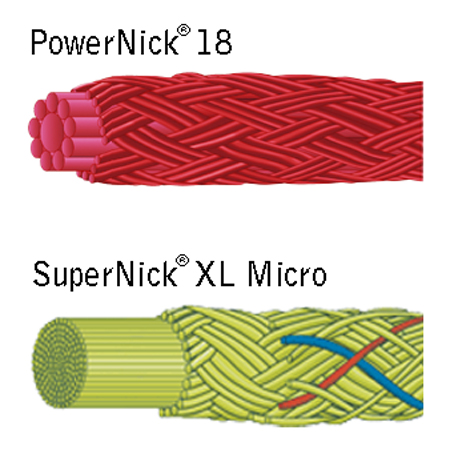By Steve Crandall, Vice President, Sales & Marketing for Ashaway Racquet Strings
In our last column we looked at some stringing habits of the pros. This time, we thought we’d go the other way and offer some stringing tips for amateur players.
String Selection
The first thing is to figure out what string is best for your game. This depends on what type of player you are and how often you play. Do you play every day, two or three times a week? Are you an avid competitor, going to every tournament you can, or do you just get out there once or twice a month to knock the ball around?
Whatever your situation, the most important criteria for string selection usually comes down to a choice between durability and playability: do you want durability, playability, or a balance between the two? This, in turn, usually comes down to a choice between a multifilament nylon and a Zyex® based string. String gauge is also an issue (which we’ll talk more about in our next column on string R&D) but, generally speaking, multifilament nylons are less durable and do not hold tension as well as Zyex-based strings. This is why, as we noted in the last column, more and more pros are switching to Zyex. However, nylon strings are also less expensive and many people just like the feel of nylon. So if you are one for whom durability is not an issue, a string such as one of our SuperNick® XL strings may be right for you.
But if you find that tension loss is an issue, or you break too many strings (which negates their lower cost), or you want a firmer string bed and more power, try a Zyex string like our PowerNick® or UltraNick® brands. These strings hold tension better, they last longer, and provide a stiffer string bed for people who want to maximize power in their game. These polymer qualities all help to ensure consistent performance over a longer period of time and make Zyex strings great for extended rallies in tough competitive matches.
But above all, string choice is individual. Just because your friend uses XYZ brand doesn’t mean it’s right for you. The more you play, the easier it is to determine your preferences, but however much you play, make it a point to consciously experiment with string, even if it means using a friend’s racquet to see how his or her string feels. The better suited your string, the better you will play and the more you will enjoy the game.
String Tension
The tension at which you have your racquet strung is also a major factor in the quality of your play. The pros know this well and are often extremely precise in their tension requirements. And again, this is a very individual choice: a single pound of tension more or less can make a big difference in your play.
Multifilament nylon strings will need to be strung a little bit tighter because they tend to lose tension after stringing. This is simply the nature of the material. Nylon is stretchy. Zyex holds tension better immediately after stringing and holds it longer. On the other hand, you have to be careful about stringing Zyex too tight because it will play dead. The string bed will be so stiff, you won’t be strong enough to take advantage of the dynamic stiffness. For multifilament nylons, we recommend stringing 28 to 32 lbs., and for Zyex strings we recommend 24 to 28 lbs.

Tips for Competitors
If you are serious about competing, you need to be consistent with your stringing, and you need to be prepared. Make sure your racquets are freshly strung, and you have more than one—preferably several racquets—ready to play. You never know when you are going to break a string and if you switch racquets, you don’t want to have to compensate for a different level of playability.
Emulate the pros. Take Nick Matthew, for example, who uses PowerNick 18. He takes six racquets to every tournament, all freshly strung by the same stringer, and all at the same precise 27 lbs. Or French up-and-comer Mathieu Castagnet. He also uses Ashaway PowerNick 18, but strung at an extremely tight 28 to 29 lbs. He brings four freshly strung racquets to every tournament, even though he’ll often use the same racquet all the way through.
So even if you are comfortable with a particular racquet and have been practicing well with it, don’t trust it, or the string, in a tournament. Have it freshly strung and have backups ready that play as close to that racquet as possible. Additionally, rotate your racquets so they are all your favorites. Number them and perhaps even keep a log of playing time with each. That way, when the inevitable happens and you break a string just when you’re ready to score that winning point in the finals (you wish!), you’ll be ready.





